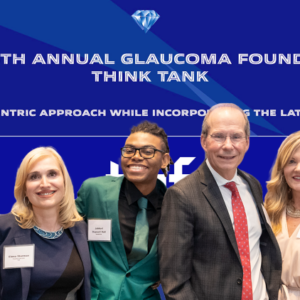October 5, 2023
Medical therapy for glaucoma has been stagnant with the most recent addition, netarsudil, introduced in 2017. There is a need for new glaucoma medications as much of the development for glaucoma therapies centers around surgical devices. Medications are needed that can impact mechanisms as to why glaucoma develops, even if they do not reduce IOP. Imagine a glaucoma treatment that prevents ganglion cell death.
GLP-1R Agonists Associated with Reduced Risk for Glaucoma in Diabetics
Glucagon-like peptide-1 receptor (GLP-1R) agonists have become popular medications due to aiding individuals to lose weight. They are used to treat Type 2 diabetes, and they are not new (approved in 2005), but their role in weight loss is. Ozempic (semaglutide) and Victoza (liraglutide) are used to treat Type 2 diabetes, with Wegovy and Saxenda, higher-dose versions of each medication, approved for weight loss. There is evidence that weight loss can improve a person’s health.1 GLP-1 is a hormone that regulates blood glucose, weight, and satiety (satiety being the satisfied feeling of being full after eating).
GLP-1R agonists cross the blood–brain barrier and affect the central nervous system, impacting cellular proliferation, mitochondrial function, and neuroinflammation.2 GLP-1R agonists have been shown to reduce microglia/macrophage activation as well as rescue retinal ganglion cells after IOP elevation in an animal model of glaucoma.3 They have been found to be neuroprotective in mouse models of neurodegenerative disease such as Alzheimer’s and Parkinson’s disease,4,5 and their use has been associated with a reduced risk for glaucoma in patients with diabetes.6
Metformin Linked to Reduced Incidence for AMD and Development of Glaucoma
Another diabetes medication that may have a role in glaucoma therapy is metformin, a biguanide derivative approved by the Food and Drug Administration (FDA) in 1994 for treating Type 2 diabetes. Metformin, a caloric-restrictive agent is the preferred first-line therapy for Type 2 diabetes. It is a relatively safe medication, inexpensive with most common side effects being gastrointestinal (GI) such as diarrhea, nausea, and vomiting. These side effects are relatively common, affecting up to 30% of patients taking metformin.7 In retinal tissues, metformin has antioxidative, anti-inflammatory, anti-angiogenic, and pro-autophagic properties.8,9 Off-label indications include its possible anti-aging, anti-cancer, and neuroprotective effects with several clinical trials examining the anti-aging question.10
Aging is a risk factor for most diseases, including glaucoma, likely because cells undergo changes over time that result in declining functionality, increased inflammation, and cell death. If aging and its cellular damage may be treatable, this could lead to different therapeutic approaches for chronic diseases such as targeting longevity and anti-apoptotic pathways in senescent cells.10 Regulation of these pathways has shown life-span-extending results in animal models.10 Still, there is no evidence yet this will work in humans.11
Metformin’s geroprotective effects are thought to be due to its role on glycemic control, caloric restriction, and improved vascular health.10, 11,12 Others believe it might be due to mechanisms beside glycemic control, such as those involving neurogenesis, inflammatory systems, longevity pathways or by backshifting the gene expression profile of an older person to resemble a younger individual.11,12,13 In animal models, metformin has been shown to lengthen the life span.9
Retrospective studies have shown individuals taking metformin for diabetes have a reduced incidence for age-related macular degeneration and development of glaucoma. Regarding glaucoma, studies have shown a dose-response with greater risk reduction when greater amounts of metformin were taken. Each 1% increase in HgA1C results in an 8% increased glaucoma risk.14 Improved glycemic control with metformin may be one way for glaucoma risk reduction, but other antihyperglycemic medications were not associated with a reduced risk of glaucoma.14 Simply lowering blood glucose does not appear to be the answer, and there may be something special with metformin contributing to the risk reduction.14 For example, metformin has shown anti-fibrotic activity in cardiac, pulmonary, and renal organ systems as well as reduced fibrosis in trabecular and human glaucoma lamina cribrosa cells.15
Ocular Hypertension and Treatment Study Yielded Surprising Results
There has been confusion regarding the relationship between diabetes and glaucoma. In an early Ocular Hypertension and Treatment Study (OHTS) publication, it was shown that diabetes protected those with ocular hypertension from developing open-angle glaucoma.16 The results were unexpected, as most studies pointed to an increased risk for glaucoma in those with diabetes. OHTS modified its classification system in order to explain the results and ended up finding more individuals reporting having diabetes, which led the results to be rereported, with neither a protective or risk effect seen.16 Still, the number of individuals with diabetes or elevated glucose in the OHTS population (25%) was greater than in the American population (10.5%), which mimicked results seen in the Blue Mountains Eye Study.16,17 The confusing results may be due to the need to separate diabetes as a disease from its therapy (metformin).
Diabetes has an association with glaucoma. The therapies for diabetes appear to have properties that also impact disease process that go beyond lowering glucose and may soon be useful for glaucoma and other chronic diseases as well as for the slowing the aging process.
Note: This article is based on a session that was part of the 2023 Glaucoma Foundation Think Tank. Watch the session here.
References
1 Baddio LL, Drucker DJ. Glugon-like peptide-1 receptor co-agonists for treating metabolic disease. Mol Metab 2021; 46:10190.
2 Drucker DJ. Mechanisms of action and therapeutic application of glucagon-like peptide-1. Cell Metab 2918; 27:749-56,
3 Liddelow SA, Guttenplan KA, Clarke LE, et al. Neurotoxic reactive astrocytes are induced by activated microglia. Nature 2017; 541:481-87.
4 Yun SP, Kam T-I, Panicker N. Block of A1 astrocyte conversion by microglia is neuroprotective in models of Parkinson’s disease. Nat Med 2018; 1-15.
5 Park J-S, Kam T-I, Lee S, et al. Blocking of microglial activation of reactive astrocytes I neuroprotective in models of Alzheimer’s disease. Acta Neuropathol Commun 2021; 9:78.
6 Sterling J, Hua P, Dunaief, JF, et al. Glucagon-like peptide 1 receptor agonist use is associated with reduced risk of glaucoma. Br J Ophthalmol 2023, 107:2:215-220.
7 Wharton S, Davies, M, Dicker D, et al. Managing the gastrointestinal side effects of GLP-1 receptor agonists in obesity: recommendations for clinical practice. Post grad med 2022; 134:14-19.
8 Qu S, Zhang C, Liu, et al. Metformin protections ARPE-19 cells from glyoxal-induced oxidative stress. Oxid Med Cell Longev 2020;1740943.
9 Han J, Li Y, Liu X, et al. Metformin suppresses retinal angiogenesis and inflammation in vitro and in vivo. PLOS One 2018;13(3):e0193031.
10 Campbell JM, Bellman SM, Stephenson MD, et al. Metformin reduces all-cause mortality and disease of ageing independent its effects on diabetes control. A systematic review and meta-analysis. Ageing Res Rev. 2017;40:31-44.
11 Nielsen LN, Bakula D, Scheibye-Knudsen M. Clinical trials targeting aging. Front aging 2022;3:821215
12 Yang D, Zhu YJ, Zhou YX, et al. Metformin in therapeutic applications in human diseases: its mechanism of action and clinical study. 2022 Mol Biomed: 3:41
13 Hou H, Moghimi S, Baxter S, et al. Is diabetes mellitus a blessing in disguise for primary open angle glaucoma? J Glaucoma 2021; 30:1-4.
14 Lin HC, Stein JD, Nan B, et al. Association of geroproective effects of metformin and risk of open-angle glaucoma in persons with diabetes mellitus. JAMA Ophthalmol 2015;133:915-923.
15 Hurley DJ, Irnaten M, O’Brien C. Metformin and glaucoma-review of anti-fibrotic processes and bioenergetics
16 Gordon MO, Beiser JA, Kass MA. Ocular hypertension treatment study group. Is a history of diabetes mellitus protective against developing primary open-angle glaucoma? Arch Ophthalmol 2008;126:280-81.
17 Mitchell P, Smith W, Chey T, et al. Open-angle glaucoma and diabetes: the Blue Mountains Eye Study, Australia. Ophthalmology 1997;712-718.
Glaucoma Foundation photo by Ayano Hisa





